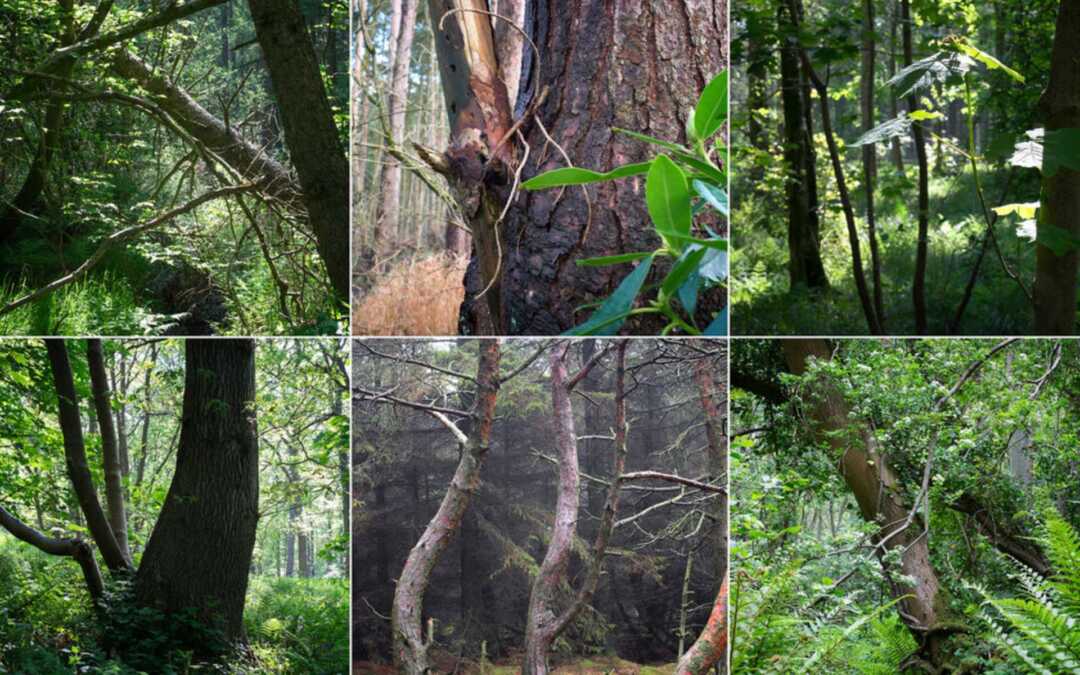Main image: Images from Tree Lines – an anthology of visual poems exploring the experience of tree by Walter Lewis (this image has been cropped for formatting requirements)
Ecoart – what is it and how do we make It count?
First Fridays are our informal gatherings/sharings, open to all. They started life as a physical place to meet up for a shared lunch followed by a live or occasionally remote presentation by an artist or group. Since May 2020 we have been gathering online which has taken away some of the social aspects but opened First Fridays up to a much wider and geographically diverse audience. Each event is on the First Friday of the month starting at 13.00 and finishing at 14.00 (UK time).
We’re grateful to our guest curator, art.earth Board member Walter Lewis. Over to you Walter…
When I first heard of the publication of Ecoart in Action (Eds. Amara Geffen, Ann Rosenthal, Chris Fremantle and Aviva Rahmani – Published by New Village Press, Feb 2022), I was excited. Case studies and provocations for successful ecoart – great, looked really helpful. When I heard that it defined ecoart as that in the overlapping space between art, science and community I was intrigued. When I bought the book and read this was part of the fundamental definition of ecoart used for inclusion in the book I was bemused. Why such a restrictive definition? Why should ecoart have to involve community…let alone science? More importantly , where does sensory experience come in?
Sure, all of us making ‘ecoart’ need to look at how we distribute our work – that which is not seen is worthless in terms of changing the world. Involving community means that this issue gets a head start – but is it the only way? Defining ecoart in such a way also seems to avoid facing up to the crucial issue of how to most effectively get it out there.
Having been allocated September Frist Friday to organise, an idea began to emerge of giving the issues an airing. We will have a look at four distinct and different ecoart practices then open up discussion to hopefully reveal some insight into how we can ‘inclusively’ work towards art changing the world. Or at least that’s the plan!
My guests are:
Victoria Burton-Davey



Moving through nature, drawing on her energies, noticing, naming, using all my senses to open pathways for nature to flow into my work. My daily engagement with landscape, and the land itself, defines and bounds my practice and my work. Exploring, collecting, selecting, intervening, installing, recording… responding to nature – drawing on her power and beauty – working from a place of deep connection and groundedness. My Land Totems, Signals and Land Runes embody my current studio practice and developing body of work.
William Bock



William Bock is an interdisciplinary artist exploring the connections between people and the environments they inhabit. He uses photography, painting, sound recording, performance and installation to delve into the experiences of living between cultures, landscapes and identities. Collaboration and responsive approaches to working with materials, particular sites and with communities are central to his process as an artist.
Dzmitry Suslau




Dzmitry received his PhD in Memory Studies from University College London, where he now lectures at the School of Slavonic and East European Studies. A specialist in public art, he has contributed to exhibition research at the Victoria & Albert Museum and other cultural institutions. His current research focuses on human ecology, critical issues in public art, and a broader connection between culture and environmental change. His practice stems from the understanding of ‘public art’ as a form of meaningful engagement with diverse publics. He is co-founder of Climate Art, a space for resident groups, artists, and scientists to come together. Climate Art’s recent site-responsive commission is longlisted for this year’s Dezeen awards.
..and I am:
Walter Lewis
I am a photographer who uses his art to explore issues around our relationship with, and inner sensibilities towards, the non-human world around us. It’s a practice based on time and place as photographic motif. Whilst documentary in form, I am also fundamentally about using photography to ‘materialise’ embodied emotional response to the world around me.
During lockdown I sought to explore my local, with particular interest in the idea of the parochial – not in its contemporary sense as pejoratively finite, but traditional sense of intimately experienced. My local woodlands have become my parochial, with individual trees and interaction with them my subject matter. I have been in deep dialogue – an evocative engagement with both local place and global ecological systems.

